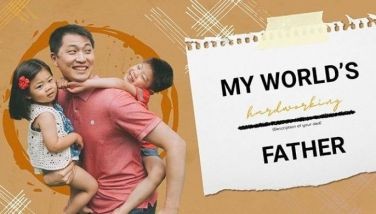SMC’s P1.03-trillion gift

Sept. 15, 2024 will be a watershed date for millions of Filipino travelers, for Philippine tourism and indeed for the country’s economy in general.
On that day, a Sunday, the Philippines’ largest conglomerate in revenues – San Miguel Corporation – takes over total management of the Ninoy Aquino International Airport (NAIA) over the next 15 years, and possibly over the next quarter century, until 2049. NAIA has four terminals – 1,2,3 and 4, with Terminal 4 serving purely domestic, short haul flights.
On Feb. 16, 2024, the Department of Transportation awarded to SMC the franchise to manage NAIA for 15 years, renewable to 25 years, with renewal to be decided by the 8th year of the contract.
SMC outbid two other prominent bidders by offering the government a whopping 82.16 percent of all airport revenues, except passenger terminal fees (where sharing will be 70 percent for government and 30 percent for SMC).
The second placer, GMR, offered 33.30 percent, while third placer, the Manila International Airport Consortium (MIAC), offered much less, 25.91 percent.
In peso terms over the next 25 years, the 82.16 percent SMC government share bid translates into a whopping P831.1 billion; GMR’s 33.30 percent into P336.9 billion and MIAC’s 25.91 percent into P262.1 billion. SMC’s revenue offer to the government of P831.11 billion is P494.2 billion more than GMR’s P336.9 and a colossal P569 billion more than MIAC’s P262.1 billion.
SMC has partnered with Incheon International Airport Corp. of South Korea to manage NAIA, beginning this September.
The GMR Group is led by Helen Yuchengco Dee of RCBC-House of Investments. GMR built the Mactan Cebu International Airport.
The MIA Consortium is composed of six conglomerates: Aboitiz, Ayala, Lucio Tan, Andrew Tan, Gokongwei and Gotianun’s Filinvest. Their infrastructure investor-partner is US-based Global Infrastructure Partners (GIP). Airports currently and previously owned or operated by consortium members include Mactan-Cebu, Clark, London Gatwick, Edinburgh, London City and Sydney.
In addition to the revenue shares, each of the bidders was required to pay the government up front and annuities a total P80 billion. Hence, SMC’s offer totals P911.1 billion, GMR’s P416.9 billion and MIAC’s P342.1 billion.
In 25 years, if government had accepted the MIAC offer of P342.1 billion as its share of revenues, it would have lost P569 billion, compared to SMC’s P911.1 billion (P911.1 billion less P342.1 billion).
If the government allowed the GMR offer, it would have lost P494.2 billion (P911.1 billion less P416.9 billion). Put another way, the two losing bidders each would have amassed easily P500 billion in additional revenues if the SMC bid was denied.
Add P911.1 billion to P123.5 billion NAIA project cost, SMC’s gift totals P1.034 trillion.
SMC president and CEO Ramon S. Ang made the government an offer it could not refuse. Why such a stupendously generous gift?
In RSA’s strategic visioning, San Miguel’s business is not beer, not beverages, not food, not flour, not feeds, not packaging, not gasoline and diesel, not energy, not tollways – but growth and development. SMC must prudently diversify into businesses that underpin the growth and development of the Philippine economy.
In so doing, SMC makes life better for most Filipinos. In the process, the company commands the loyalty of its clients and consumers, today and in the long pull. San Miguel, after all, is the largest consumer products company in Southeast Asia, aside from being the Philippines’ largest industrial company.
SMC makes annual revenues of P1.5 trillion, 5.9 percent of Philippine GDP of P25.27 trillion. No other company contributes as much to annual economic production and services.
Meanwhile, aviation (mainly NAIA), according to the International Air Transport Association, contributes 3.4 percent of Philippine GDP.
Per IATA, Philippine aviation currently employs 1.2 million people – in 45,000 jobs directly, 127,000 in supply chain, 37,000 in employee spending and 954,000 in tourism. In revenues, aviation contributes $10.4 billion in gross value added – $1.4 billion directly, $900 million in the supply chain, $300 million in employee spending and $7.7 billion in spending by foreign tourists.
This 2024, the Department of Tourism projects international visitor arrivals of 7.7 million, from a paltry 5.45 million in 2023. With a more efficient airport and less airport congestion, the Philippines should easily attract 10 million arrivals this year, on top of 40 million in domestic tourists; 90 percent of them go through NAIA.
With NAIA under its management, SMC’s total contribution to annual economic production should hit 9.3 percent of GDP (5.9 percent plus 3.4 percent), an awesome share by any measure. Beginning 2025, P9 of every P100 of national economic output will be contributed by just one company, SMC.
RSA uncorked his strategy when he announced the largest and most massive diversification ever by any Philippine conglomerate in 2007. Today, more than 60 percent of SMC revenues come from its diversification.
Per the experience of airport economies like Singapore, Qatar and Dubai, world-class airports are the best way to pump-prime an economy.
Coincidentally, by 2049, if not earlier, per forecasts of major global think tanks, the Philippines will be one of the world’s 12 richest countries in terms of the dollar value of its economic production or GDP.
Today, the Philippine GDP, in purchasing power parity (PPP) terms, or what the dollar can buy in local goods, is worth $1.2 trillion.
In 2022, Goldman Sachs ranked the Philippines the 14th largest economy by 2075, with real GDP of $6.6 trillion, bigger than France’s $6.5 trillion, based on 2021 dollars. The only ASEAN country larger than the Philippines will be Indonesia, with GDP of $13.7 trillion, fourth largest, by 2075.
The Philippines overtakes all its ASEAN neighbors, except Indonesia, in economic growth. Goldman Sachs made these projections in 2021, before the government awarded the NAIA rehab and management to SMC this year.
* * *
Email: biznewsasia@gmail.com
- Latest
- Trending






























